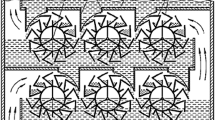Abstract
One of the most effective energy saving technologies is the improvement of existing heat and mass exchange units. A stream-bubble contact device is designed to enhance the operation efficiency of heat and mass exchange units. The stages of the stream-bubble units that are proposed by the authors for the decarbonization process comprise contact devices with equivalent sizes, whose number is determined by the required performance of a unit. This approach to the structural design eliminates the problems that arise upon the transition from laboratory samples to industrial facilities and makes it possible to design the units of any required performance without a decrease in the effectiveness of mass exchange. To choose the optimal design that provides the maximum effectiveness of the mass-exchange processes in units and their intensification, the change of the mass-transfer coefficient is analyzed with the assumption of a number of parameters. The results of the study of the effect of various structural parameters of a stream-bubble contact device on the mass-transfer coefficient in the liquid phase are given. It is proven that the mass-transfer coefficient increases in the liquid phase, in the first place, with the growth of the level of liquid in the contact element, because the rate of the liquid run-off grows in this case and, consequently, the time of surface renewal is reduced; in the second place, with an increase in the slot diameter in the downpipe, because the jet diameter and, accordingly, their section perimeter and the area of the surface that is immersed in liquid increase; and, in the third place, with an increase in the number of slots in the downpipe, because the area of the surface that is immersed in the liquid of the contact element increases. Thus, in order to increase the mass-transfer coefficient in the liquid phase, it is necessary to design the contact elements with a minimum width and a large number of slots and their increased diameter; in this case, the filling degree of contact elements by the liquid must be maximum.
Similar content being viewed by others
References
Energetic Efficiency in Russia. Burried Reserve. An account prepared by experts of world bank, International finance corporation and Center of effective use of energy, 2008. http://www.cenef.ru/file/FINAL_EE_report_rus.pdf.
Energetic Strategy of Russia for the Period to 2020, Approved by Russian Federation Government Order No. 1715-r on November 13, 2009.
A. G. Laptev, N. A. Nikolaev, and M. M. Basharov, Methods of Intensification and Modeling of Heat-Mass-Exchange Processes: Tutorial and Handbook (Teplotekhnik, Moscow, 2011) [in Russian].
I. L. Leites, “On economy of energetic resources in chemical and petroleum-chemical technology,” Khim. Prom., No. 1, 2–3 (2000).
V. I. Sharapov and M. A. Sivukhina, Decarbonifiers of Water Preparation Plants in Heat Supply Systems (ASV, Moscow, 2002) [in Russian].
I. N. Madyshev, O. S. Dmitrieva, and A. V. Dmitriev, “Perspectives of use of stream–barbotage contact mechanisms for increase of energy efficiency of mass-exchange devices,” Ekol. Prom. Ross. 19, 36–39 (2015).
N. Kolev, B. Kralev, and D. Kolev, “Gas side controlled mass transfer in a new packing with stamped horizontal lamellae operating at extremely low liquid loads,” Chem. Eng. Proc.: Process Intensif. 63, 44–49 (2013).
J. Mackowiak, “Model for the prediction of liquid phase mass transfer of random packed columns for gasliquid systems,” Chem. Eng. Res. Des. 89, 1308–1320 (2011).
D. Bessou, M. Rouzineau, F. Prévost, C. Abbé, J.-P. Dumont, M. Maumus, and M. Meyer, “Performance characteristics of a new structured packing,” Chem. Eng. Sci. 65, 4855–4865 (2010).
Z. J. Wei, Z. L. You, and S. Q. Gui, “Gas pressure drop and mass transfer characteristics in a cross-flow rotating packed bed with porous plate packing,” Ind. Eng. Chem. Res. 49, 3732–3740 (2010).
A. V. Dmitriev, O. S. Dmitrieva, I. N. Madyshev, G. S. Sagdeeva, and A. N. Nikolaev, RF Patent 156379, Byull. Izobret. 2015, no. 31.
P. V. Danckwerts, “Gas absorption accompanied by chemical reaction,” Am. Inst. Chem. Eng. J. 1, 456–463 (1955).
N. A. Voinov, O. P. Zhukova, O. V. Kurganskii, and E. E. Vyrina, “Mass exchange in flowing bioreactor with liquid recirculation,” Khim. Rastit. Syr’ya, No. 3, 241–246 (2014).
Author information
Authors and Affiliations
Corresponding author
Additional information
Original Russian Text © A.V. Dmitriev, O.S. Dmitrieva, I.N. Madyshev, 2016, published in Teploenergetika.
Rights and permissions
About this article
Cite this article
Dmitriev, A.V., Dmitrieva, O.S. & Madyshev, I.N. Determination of the mass-transfer coefficient in liquid phase in a stream-bubble contact device. Therm. Eng. 63, 674–677 (2016). https://doi.org/10.1134/S0040601516080036
Published:
Issue Date:
DOI: https://doi.org/10.1134/S0040601516080036




